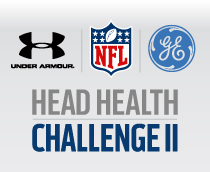

University of Washington (UW) and its commercial partner, Vicis, Inc. were among seven organizations to win $500,000 grants to develop technology to better protect against concussions and brain injury from Head Health Challenge II, a collaboration between the NFL, GE and Under Armour.
The winners will also have the opportunity to receive an additional $1,000,000 to advance their work to better protect against brain injury.
More than 500 proposals from 19 countries were submitted to Head Health Challenge II, which will award up to $8.5 million for new innovations and materials that can protect the brain from traumatic injury.
"The disruptive ideas introduced by these seven entities are designed to increase brain safety for athletes, members of the armed forces and society at-large," the consortium said in announcing the winners.
UW and Vicis are developing a new football helmet designed to mitigate the forces likely to cause concussion.
This technology breakthrough is a result of collaboration between global thought-leaders in neurosurgery and mechanical engineering at University of Washington. Together with proven business leaders, they are committed to using science to protect athletes.
Results from the UW/Vicis technology show unprecedented reduction in linear and rotational acceleration, the forces likely to cause concussion.
“Innovation in football helmet technology is long overdue,” said Dave Marver, CEO of Vicis. “Today’s helmets were designed to protect against skull fracture but offer little protection against concussion. Our win validates this helmet’s promise as a significant advance in protective technology.”
The UW/Vicis initiative has received grant funding from University of Washington's Center for Commercialization and the Coulter Foundation. The company has also received an investment from the W-Fund, a Seattle-based venture capital fund, and Seattle-based Alliance of Angels. Vicis founders include Per Reinhall, PhD, Chairman of Mechanical Engineering at UW and Samuel Browd, MD, PhD, Pediatric Neurosurgeon and Medical Director of the Sports Concussion Program at Seattle Children's Hospital.
Vicis is developing an improved football helmet designed to mitigate forces likely to cause concussion. The Vicis team was initially formed by UW pediatric neurosurgeon Samuel Browd. It includes thought-leading engineers and neurosurgeons, public health experts, and proven business leaders committed to using science to protect athletes.
Other winners include:
Army Research Laboratory, Baltimore, MD—The Army Research Laboratory (ARL) created rate-dependent tethers that allow free motion at low speeds, but provide high force resistance during high-speed events. ARL proposes using these smart materials to connect the head to the torso, allowing voluntary head movement during sports action, while minimizing sudden accelerations caused by high speed collisions, often associated with concussions. Beyond sports, this technology also has the potential to mitigate head trauma for members of the military.
Emory University, Atlanta, GA—Researchers and engineers from Emory University and the Georgia Institute of Technology developed a prototype medical device that can screen and assess concussions in near real-time. The portable device, known as iDETECT, can be used on the sidelines of sporting events. It consists of a headset and handheld device that rapidly assesses the player's symptoms, including cognitive function, balance and eye movements.
UCLA, Los Angeles, CA—UCLA and Architected Materials, Inc. are developing a new energy-absorbing microlattice material for improved helmet performance. They are developing a material to be used as a new under-helmet liner that would absorb significantly more energy than current designs and therefore better protect the brain. Through a collaboration of material designers, mechanical impact experts, and neuroscientists, they will utilize a new 3D printing platform to develop real-time responsive helmet technology.
University of Miami, Miami, FL—The University of Miami Miller School of Medicine, in collaboration with the University of Pittsburgh School of Medicine, and Neuro Kinetics, Inc., is developing a portable eye-goggle that gathers and measures precise eye movements. The I-Portal PAS goggle will assist in identifying mild traumatic brain injury in real time, leading to more accurate concussion diagnosis. This advanced research into traumatic brain injuries has received funding support from the U.S. military at the Army Medical Research and Materials Command and the Department of Defense Hearing Center of Excellence.
University of New Hampshire, Durham, NH—University of New Hampshire researcher Erik Swartz will lead a study to evaluate the effectiveness of a helmet-less tackling training system called the HuTTTM Technique. Proposed as an intervention for head impact prevention in high school football, this technique emphasizes proper tackling and blocking technique using closely supervised drills where players participate without their helmets and shoulder pads. UNH will investigate whether regular implementation of the HuTTTM technique results in player behaviour change and reduces injury risk by reinforcing proper technique when players go into full-equipment play.
Viconic, Inc., Detroit, MI—Viconic's research is focused on developing an underlayer for synthetic turf systems that will make fields safer for those who play on them. Viconic's technology is widely used for impact management in the automotive and sporting industries and in the U.S. Military. Viconic will further explore the relationship between optimized head impact protection and the frequency of lower limb injuries in an effort to provide the synthetic turf industry a tool to specify systems that maximize player safety and minimize safety costs.
Videos demonstrating each winner's technology can be viewed at the Head Health Challenge II website.

There are no comments
Please login to post comments